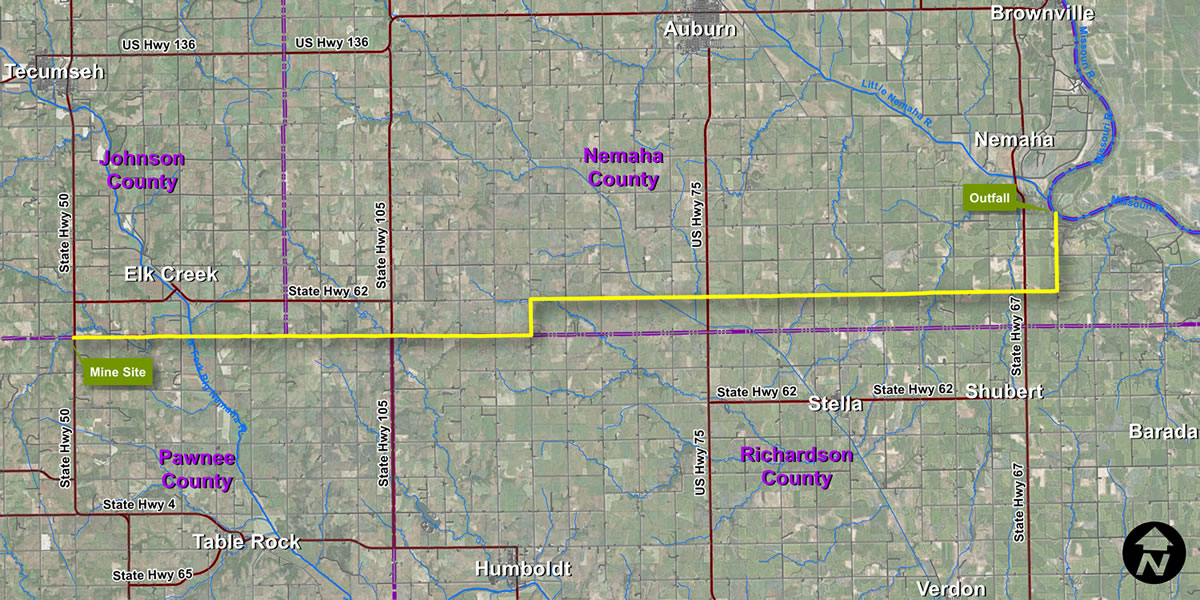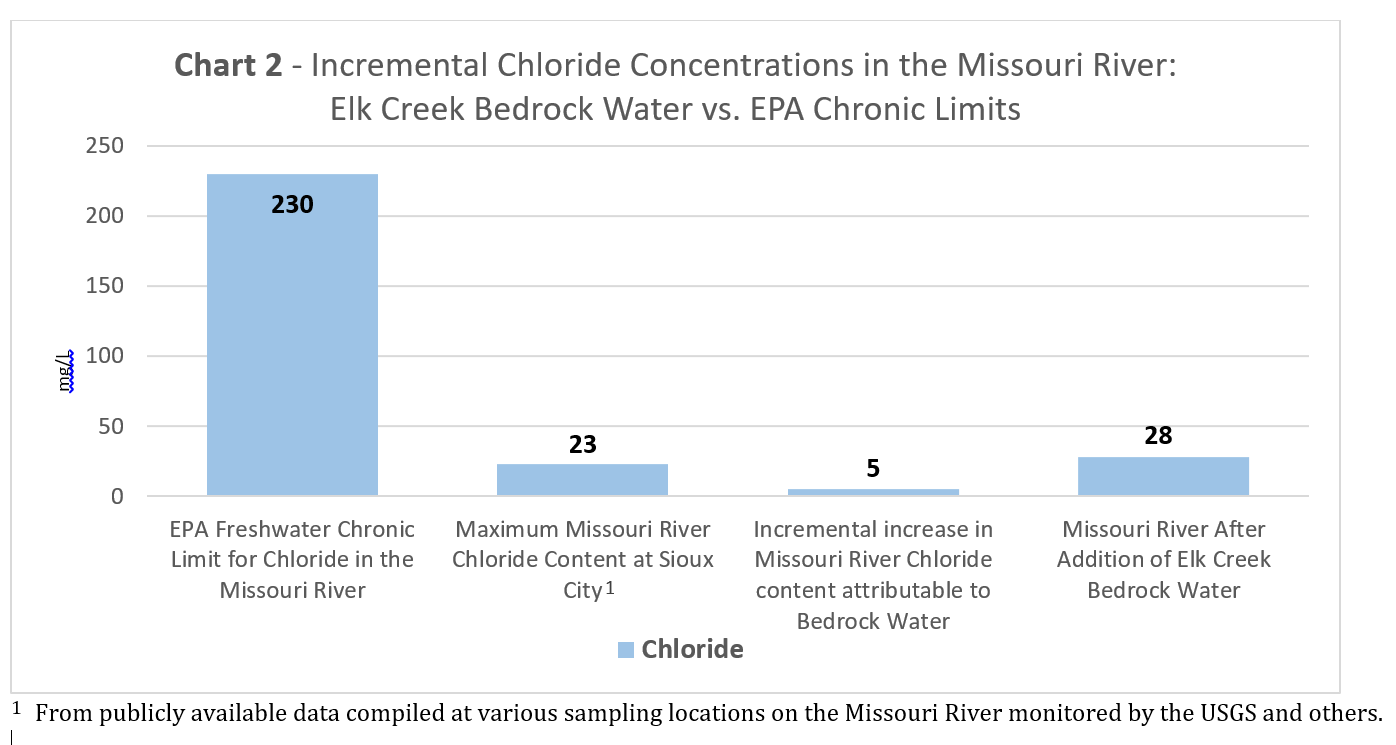Waterline’s Path is Designed to Minimize Impacts to County Roads and to the Environment, and Could Deliver an Added Water Resource to Downstream Agricultural and Other Water Consumers
CENTENNIAL, Colo. – October 17, 2016 – NioCorp Developments Ltd. (“NioCorp” or the “Company”) (TSX: NB; OTCQX: NIOBF; and FSE: BR3) is pleased to announce that County Commissions in all four Southeast Nebraska counties involved in NioCorp’s proposed Elk Creek Project waterline have expressed preliminary public support for the waterline, which will increase Nebraska’s contribution to Missouri River water flows and may deliver an added water resource to downstream agriculture and other water consumers.
The proposed Elk Creek waterline would transport to the Missouri River approximately 9,500 gallons per minute (GPM) of naturally salty (“brackish”) water produced as the Elk Creek mine is dewatered over the mine’s estimated 32-year lifespan. Dewatering is a common practice in underground mining, and in this project dewatering involves drawing water from bedrock that exists below the area’s freshwater aquifer and beneath an additional 500 feet of impermeable limestone. The bedrock water is naturally brackish and does not mix with any freshwater resource in the project area.
NioCorp representatives recently presented the outlines of its proposed 30-mile waterline in public meetings with officials in Johnson, Nemaha, Pawnee, and Richardson counties in Southeast Nebraska. The preferred route is designed to minimize impacts to existing paved roads and to streams and wetlands.
None of the county officials expressed opposition to the waterline, and a number of officials voiced public support for the concept during the public meetings where the Company presented its proposals, according to Mark A. Smith, NioCorp’s Executive Chairman and CEO.
“We are very pleased with the initial reception by local Nebraska leaders to the Elk Creek waterline concept,” said Mr. Smith. “Scott Honan and his team have worked very hard to minimize its potential impact on multiple levels. We examined three main alternatives for the route as well as a number of sub alternatives to each main alternative. The alignment we intend to propose in our final Feasibility Study and for ongoing permitting is one that avoids paved roads as well as minimizes impacts to waterbodies and wetlands. It also maximizes the use of existing rights of way as much as possible, so that we minimize the need to access private land.”
“We are continuing to work to complete all necessary environmental surveys for the preferred alignment, and crews are in the field right now,” Mr. Smith added.
Bedrock Water Achieves Aquatic Freshwater Quality Within 5,000 Feet of its Missouri River Run
The bedrock water is naturally brackish, and has a salt content of approximately 18,000 milligrams/Liter (mg/L). By comparison, seawater typically contains 35,000 mg/L of salt. NioCorp’s has estimated that the addition of the bedrock water will increase the average chloride content of the Missouri River by approximately 5 parts per million (ppm or mg/L) to a total of approximately 30 mg/L, from a natural background of approximately 25 mg/L. These levels are well below the U.S. Environmental Protection Agency’s acute limit for chloride in freshwater systems, which is 860 mg/l, and EPA’s chronic limit for chloride in freshwater systems, which is 230 mg/l. Charts showing the waterline’s chloride contributions to the Missouri River in relation to EPA’s acute and chronic limits are provided below.
“Elk Creek bedrock water will not appreciably increase the Missouri River’s salinity in relation to either of these regulatory limits,” said Scott Honan, President of Elk Creek Resources Corporation (“ECRC”), the wholly owned operating subsidiary of NioCorp. “Moreover, once released into the Missouri River, this bedrock water is expected to mix rapidly with the river’s flow and will achieve the standard of aquatic freshwater quality within less than 5,000 feet from the point of discharge. That raises the interesting potential that this bedrock water could provide additional water resources for downstream constituencies.”
According to a beneficial use assessment that examined potential alternatives for this ECRC bedrock water, produced by Frank Kwapnioski of H2Options Engineering LLC, the Elk Creek waterline to the Missouri River is the best option. Of the multiple alternatives assessed in the report, the Elk Creek waterline provides the most timely, feasible, and reliable solution while also potentially producing downstream beneficial value from the bedrock water.
Kwapnioski, a water resources professional with over 40 years of experience in Nebraska, said: “Not only is this Elk Creek waterline the most effective option for NioCorp, but the high dilutive potential of the Missouri River will make up to 9,500 gallons per minute of additional good quality water available to downstream water users.”
Former Nebraska Lt. Governor Lavon Heidemann, who farms near the proposed Elk Creek Project and who consults with NioCorp, added: “The Elk Creek Superalloy Materials Project has the potential to deliver a wide range of benefits to people across southeastern Nebraska and to our entire state. The waterline portion of the project was designed to minimize impacts on existing county roads and to minimize environmental impacts on streams and wetlands. I applaud county leaders for their willingness to consider how we can complete this waterline as efficiently as possible, given that its construction will help the Elk Creek Project move to commercial reality that much faster.”
The current proposed routing of the Elk Creek waterline is show below.

Background: Elk Creek Bedrock Water Impacts On Missouri River Salinity In Relation To Federal Regulatory Limits


On Behalf of the Board of Directors:
“Mark Smith”
Mark Smith
Executive Chairman, CEO and Director
# # #
Source: NioCorp Developments, Ltd.
@NioCorp $NB $NIOBF #Niobium #Scandium #ElkCreek
For More Information
Contact Jim Sims, VP of External Affairs, NioCorp Developments, Ltd., 720-639-4650, [email protected]
About NioCorp
NioCorp is developing the Elk Creek Niobium / Scandium / Titanium project in Southeast Nebraska. Niobium is used to produce High Strength, Low Alloy (“HSLA”) steel, which is a lighter, stronger steel used in automotive, structural, and pipeline applications. Scandium can be combined with Aluminum to make an alloy with increased strength and improved corrosion resistance. Scandium is also a critical component of advanced solid oxide fuel cells. Titanium is a key component of pigments used in paper, paint and plastics and is also used for aerospace applications, armor and medical implants.
Cautionary Note Regarding Forward-Looking Statements
Certain statements contained in this document may constitute forward-looking statements, including but not limited to statements regarding the future path of the waterline, the potential future effects of the waterline and the water discharged from the Company’s Elk Creek project in to the Missouri river, future support of the waterline and the Elk Creek Project by Nebraska county leaders, the future benefits of the Elk Creek Project to persons in southeast Nebraska and other similar statements. Such forward-looking statements are based upon NioCorp’s reasonable expectations and business plan at the date hereof, which are subject to change depending on economic, political and competitive circumstances and contingencies. Readers are cautioned that such forward-looking statements involve known and unknown risks, uncertainties and other factors that may cause a change in such assumptions and the actual outcomes and estimates to be materially different from those estimated or anticipated future results, achievements or position expressed or implied by those forward-looking statements. Risks, uncertainties and other factors that could cause NioCorp’s plans or prospects to change include changes in demand for and price of commodities (such as fuel and electricity) and currencies; changes or disruptions in the securities markets; legislative, political or economic developments; the need to obtain permits and comply with laws and regulations and other regulatory requirements; the possibility that actual results of work may differ from projections/expectations or may not realize the perceived potential of NioCorp’s projects; risks of accidents, equipment breakdowns and labor disputes or other unanticipated difficulties or interruptions; the possibility of cost overruns or unanticipated expenses in development programs; operating or technical difficulties in connection with exploration, mining or development activities; the speculative nature of mineral exploration and development, including the risks of diminishing quantities of grades of reserves and resources; risks involved in the exploration, development and mining business and the risks set forth under the heading “Risk Factors” in the Company’s S-1 registration statement and other filings with the SEC at www.sec.gov. NioCorp disclaims any intention or obligation to update or revise any forward-looking statements whether as a result of new information, future events or otherwise.
